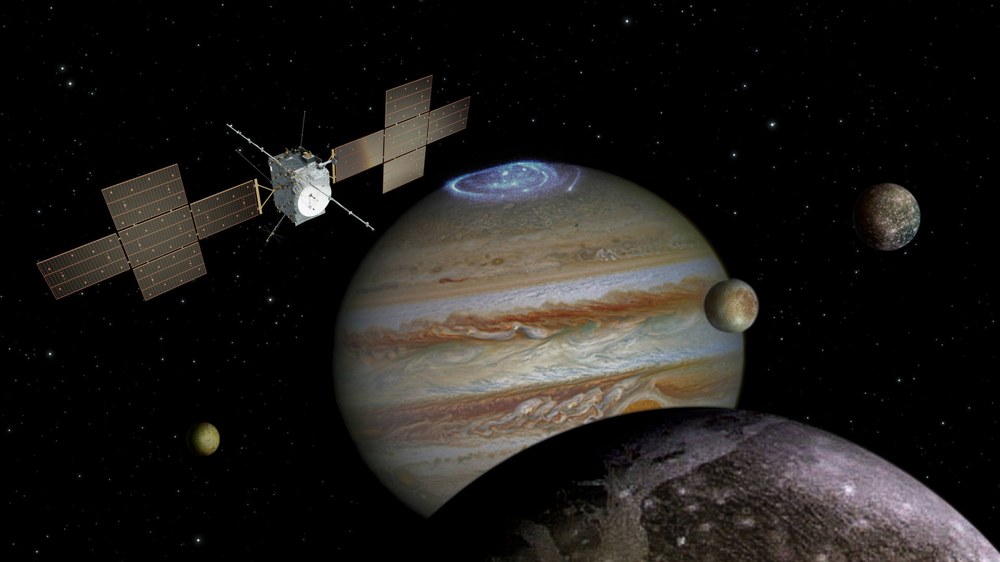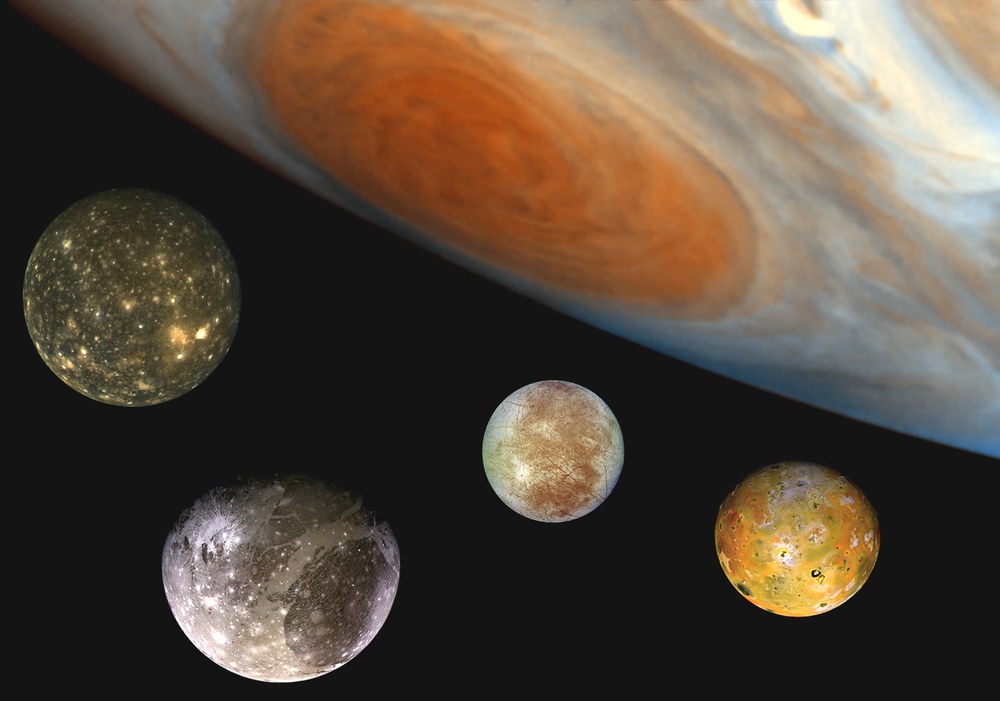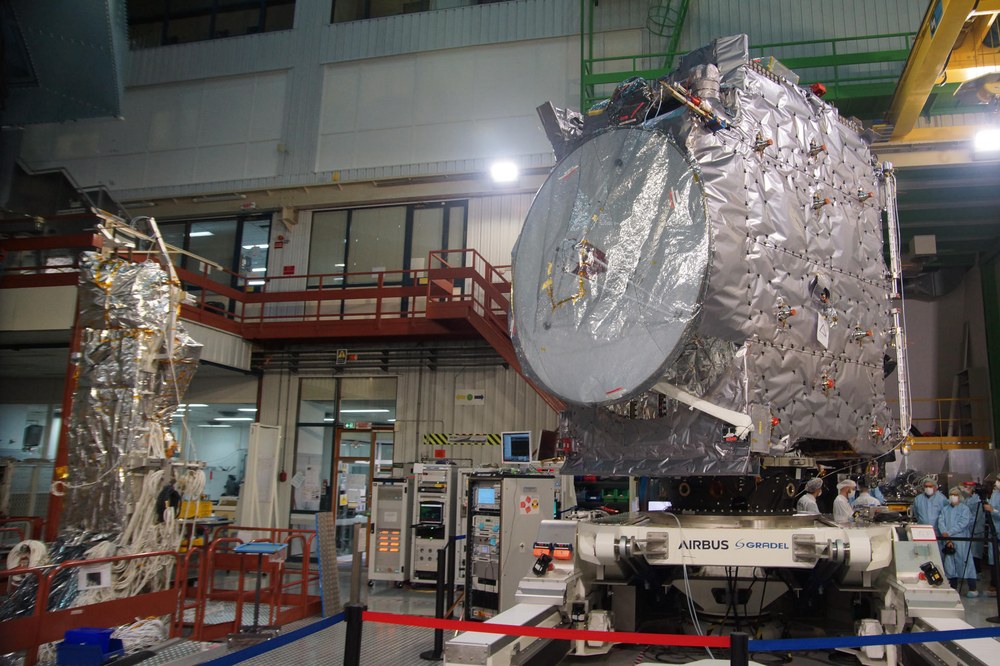From Europe to Jupiter via Kourou

ESA/ATG medialab (Sonde); NASA/JPL/DLR (Jupiter, Monde)


- The Jupiter Icy Moons Explorer (JUICE) spacecraft is in Toulouse being prepared for transport to Europe's spaceport in Kourou. The spacecraft is scheduled for launch in April on an Ariane 5 launcher.
- After arriving in the Jupiter system in July 2031, JUICE will study the planet and its icy moons from orbit, first around Jupiter and later around Ganymede.
- DLR is providing the Ganymede Laser Altimeter (GALA) and significant contributions to the JANUS camera. The German Space Agency at DLR provides funding to a total of seven instruments on JUICE.
- Focus: Jupiter, icy moons, exploration, search for life
"Trois, deux, un – et décollage!" This is how the last three seconds will be counted down in the control centre in Kourou, French Guiana, this April before one of the last Ariane 5 launch vehicles lifts off from Europe's Spaceport. The target of the European Space Agency's (ESA) largest planetary mission to date is Jupiter and its large icy moons Ganymede, Callisto and Europa. The Jupiter Icy Moons Explorer (JUICE) will study them up close from 2031 onwards. Under their icy crust, the moons could likely harbour oceans in which life could possibly exist. The Institute of Planetary Research at the German Aerospace Center (Deutsches Zentrum für Luft- und Raumfahrt; DLR) played a major role in the construction of two of the ten scientific instruments. The German Space Agency at DLR manages the German ESA contributions to JUICE on behalf of the German government and will provide approximately 100 million euros of funding across seven of the spacecraft’s instruments over the life of the mission.
By air to South America
JUICE must first be transported from Europe to South America. At present, the spacecraft, which has not yet been fuelled and weighs approximately 2400 kilograms empty, is located at the industrial prime contractor, Airbus Defence and Space, in Toulouse, southern France. There it was presented to the media on 20 January 2023 before being packed for transport to Kourou on an Antonov cargo aircraft. The transport across the Atlantic will take place in early February. In Kourou, the spacecraft will then be placed on the Ariane 5 ECA launcher and encased in a protective fairing. When fuelled, the JUICE spacecraft will weigh 6.1 tonnes. The launch window for the eight-year journey to Jupiter opens in April.
JUICE is the first L-class mission in ESA's Cosmic Vision programme, where the L stands for Large. The aim of this programme is to improve our understanding of the Solar System, including how the planets formed and under what conditions life can develop – Earth being our only current example. JUICE is a large project with its extensive scientific payload. Its target is Jupiter, the largest planet in the Solar System. It is five times as far away from the Sun as Earth, has a diameter of 140,000 kilometres – ten times as large and 318 times as massive as our home planet – and is orbited by a total of 79 moons. Of these, the four largest – Ganymede, Callisto, Io and Europa – are of enormous scientific interest. They are referred to as the Galilean moons after their discoverer, Galileo Galilei (1564-1641).
Three ice worlds and a volcanic hellscape
Io, the innermost of the four, is so violently deformed by the planet's tidal forces that magma is permanently formed in the rock mantle at temperatures of well over 1000 degrees Celsius. This molten rock is transported to the surface by enormous volcanoes. Sulphur-yellow Io is the most volcanically active body in the Solar System. From the innermost outwards, the three satellites Europa, Ganymede and Callisto follow. Ganymede, with a diameter of 5262 kilometres, is the largest moon in the Solar System; Europa and Io, with diameters of less than 4000 kilometres, are about as large as Earth's Moon; Callisto, with a diameter of 4821 kilometres, is the third largest moon in our planetary system.
It takes Europa twice as long as Io to orbit Jupiter; Ganymede four times as long. This means that these three moons repeatedly line up like a string of pearls. This creates resonance effects that, through interactions with the powerful gravitation and tidal forces emanating from Jupiter, generate heat in the interior of Europa and Ganymede. This causes enough heat to be present under their ice crusts, which are as cold as minus 160 degrees Celsius, which prevents water from freezing even at a distance of over 700 million kilometres from the Sun. This sustains deep layers of water, called subsurface oceans.
Oceans (and life?) under kilometre-thick ice crusts
In the case of Europa, it could be that the ocean under the ice crust, which is only a few kilometres thick, is more than 100 kilometres deep. This would mean that there is more water under the moon's surface than in all the oceans on Earth combined. There could also be an ocean below the surface of Callisto; as with Ganymede, magnetic field measurements have provided clear indications here. Both Ganymede and Callisto could have several layers of water, but located at greater depths.
Water is a basic prerequisite for the emergence and development of life as we know it. It is therefore conceivable that, hidden from the view of observations made from space, life has developed in the subsurface oceans of Jupiter's icy moons. JUICE will not be able to determine this, but it will be able to characterise the icy moons in more detail than NASA's Voyager (flyby 1979) and Galileo (orbiter, 1995-2003) missions, as well as confirm the presence of the oceans, how deep they are, how much water they contain and which mineral substances could be dissolved in the water.
The JANUS camera maps Ganymede and Europa
One of the JUICE instruments that will be used to answer these and other questions is the JANUS camera system. The main task of JANUS is to photographically record and map Ganymede and Europa It is also intended to record and interpret the visible effects of tidal forces on the surfaces, which are responsible for the subcrustal oceans. This includes tectonic phenomena such as fissures and ridges or spectral changes caused by the presence of different minerals produced as a result of cryovolcanism.
For this purpose, the camera system has 13 spectral channels in the visible light and near infrared spectral ranges in addition to a high spatial resolution. Io, and many of the smaller moons, will also be observed from a distance. JANUS was developed in Italy, Germany, Spain and the UK, and parts of the hardware were built at the DLR Institute of Planetary Research.
Tracking the oceans with lasers
The Ganymede Laser Altimeter (GALA) will measure the tidal deformation of Ganymede's ice crust to provide evidence for the existence of the global interior ocean. In addition, several million time-of-flight measurements will be used to produce a comprehensive map of the moon's regional and local topography, which will be assembled into a global elevation model of Ganymede. This will allow us to understand the processes that shaped the unique surface of this icy moon. The tidal deformation of the satellite's shape will also be determined using measurements taken at different times during Ganymede's seven-day orbit around Jupiter. From the strength of the deformation at the different orbital points, the existence of the inner ocean can be proven, and the mechanical properties of the overlying ice layer determined.
The altimeter will also be used to acquire measurements of Europa and Callisto. While researchers hope to find evidence of water just below Europa’s surface, in the case of Callisto it is likely to be found in deeper layers. GALA was developed under DLR's supervision, in collaboration with industrial partner HENSOLDT Optronics GmbH (Oberkochen) and research institutions from Germany, Japan, Switzerland and Spain. It will be the first time that such an instrument has been used in the outer Solar System.
Weather forecast for Jupiter and its moons
Another instrument from Germany on board JUICE is the Sub-millimetre Wave Instrument (SWI), which is the primary responsibility of the Max Planck Institute for Solar System Research in Göttingen. It will be used to examine the middle atmospheric layers of the gas giant Jupiter as well as the extremely thin atmospheres – or more correctly, 'exospheres' – and surfaces of the Galilean moons. The focus will be on determining the thermal structure, dynamics and composition of the various layers of Jupiter's atmosphere and how they interact, as well as Jupiter's internal structure.
ESA mission with strong German participation
JUICE is the largest and most comprehensive ESA mission to explore a planetary system within the Solar System. NASA and the Japanese Aerospace Exploration Agency (JAXA) have also contributed to the mission. ESA provides funding for the satellite platform, the Ariane 5 ECA launcher and the operation of the spacecraft. The funding for the scientific payloads for JUICE is largely provided by national space agencies and the participating institutes. In addition to the JANUS, SWI and GALA instruments, the German Space Agency at DLR is funding further German scientific contributions from the national space programme to the Particle Environment Package (PEP) particle spectrometer, the Jupiter Magnetometer (J-MAG), the Radar for Icy Moons Exploration (RIME) radar instrument and the 3GM instrument for radio sounding of Jupiter's atmosphere.
JUICE will reach Jupiter in July 2031 and complete a total of 35 flybys of the moons by November 2035. In September 2034, the spacecraft will be steered into an elliptical, later circular, orbit around Ganymede. JUICE will be the first mission to orbit the moon of another planet. By the time the mission ends in September 2035, JUICE will have orbited Ganymede approximately 1250 times. Should fuel still be available, further orbits will take place at an altitude of just 200 kilometres, enabling measurements of a quality that would set the standard for decades to come. At the end of the mission, the spacecraft will be deliberately steered to crash into the surface of Ganymede and be completely destroyed in the collision with the rock-hard ice. As the suspected ocean inside Ganymede is estimated to be 100 kilometres deep and night temperatures below minus 160 degrees Celsius, there is no danger of contamination of Ganymede’s ocean by terrestrial microbes that might have travelled along on JUICE as 'stowaways'.
